| News Archive |

|
2008: Jan Feb Mar Apr May Jun Jul Aug Sep Oct Nov Dec
2007: Jan Feb Mar Apr May Jun Jul Aug Sep Oct Nov Dec
2006: Jan Feb Mar Apr May Jun Jul Aug Sep Oct Nov Dec
2005: Jan Feb Mar Apr May Jun Jul Aug Sep Oct Nov Dec
2004: Jan Feb Mar Apr May Jun Jul Aug Sep Oct Nov Dec

News: June 2008
Back to latest news

|
SOHO discovers its 1,500th comet
The SOlar and Heliospheric Observatory (SOHO) is celebrating the discovery of 1,500 comets since the mission began 13 years ago, making it more successful than all other comet discoverers throughout history put together.
 FULL STORY FULL STORY
 |
 |
 |
 |
Phoenix soil could support life
The results of the first ‘wet chemistry’ experiments on Mars soil were returned to Earth last week, revealing conditions that could support life as we know it.
 FULL STORY FULL STORY
 |
 |
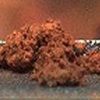 |
 |
One hundred not out
The impact event that rocked the unsuspecting Siberian outback 100 years ago today may hold the secrets to the protection of our precious blue planet against a similar cosmic assault in the future.
 FULL STORY FULL STORY
 |
 |
 |
 |
Twin galaxies in cosmic
arm wrestle
Astronomers at the Gemini Observatory have captured the early stages of gravitational interaction between two similar galaxies as they tug on each other’s spiral arms.
 FULL STORY FULL STORY
 |
 |
 |
 |
Massive impact on Mars supported by computer simulations
The dramatic differences between the topography of the northern and southern hemispheres of Mars, which have been explained by many different theories including that of a giant asteroid impact, could finally be supported by computer simulations of such a planet sculpting collision.
 FULL STORY FULL STORY
 |
 |
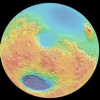 |
 |
World’s largest camera to observe Dark Energy
An important milestone has been reached in the quest for detecting the mysterious Dark Energy component of our Universe with the development of one of the largest imaging systems in the world, which comprises five lenses and a 500 megapixel camera.
 FULL STORY FULL STORY
 |
 |
 |
 |
Water-seeking Moon spacecraft passes major preflight tests
NASA’s Lunar Crater Observation and Sensing Satellite (LCROSS) is one step closer to determining whether water ice exists in a permanently shadowed crater near the lunar south pole, having passed rigorous preflight testing earlier this month.
 FULL STORY FULL STORY
 |
 |
 |
 |
Lazy pulsar powered by companion
XMM-Newton has, for the first time, detected X-ray pulses emanating from both stars of a closely packed binary pulsar system, revealing two extremely dense rapidly rotating neutron stars.
 FULL STORY (includes video) FULL STORY (includes video)
 |
 |
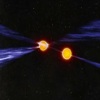 |
 |
Galaxy cannibals eat their neighbours
Previously unseen galactic cannibalism within the supermassive black holes that occupy the centres of Seyfert galaxies has been revealed by radio observations courtesy of the Very Large Array (VLA).
 FULL STORY FULL STORY
 |
 |
 |
 |
Hawaiian lava holds clues for planetary evolution
Precision analysis of lava samples taken from the Kilauea Iki volcanic crater in Hawaii has given planetary scientists a new tool for reconstructing planetary origins.
 FULL STORY FULL STORY
 |
 |
 |
 |
Frozen water confirmed on Mars
"It is with great pride and a lot of joy that I announce today that we have found proof that this hard bright material is really water ice and not some other substance," says Phoenix Principal Investigator Peter Smith of The University of Arizona.
 FULL STORY FULL STORY
 |
 |
 |
 |
Earth’s laws still apply in distant Universe
One of the most important numbers in physics, the proton-electron mass ratio, is the same in a galaxy six billion light years away as it is here on Earth, according to new research, laying to rest debate about whether the laws of nature vary in different places in the Universe.
 FULL STORY FULL STORY
 |
 |
 |
 |
Black holes have simple feeding habits
The results of a massive observing campaign of spiral galaxy M81 have shed light on the feeding habits of different sized black holes, and provide a benchmark for predicting the properties of a new class of black hole.
 FULL STORY (includes video) FULL STORY (includes video)
 |
 |
 |
 |
Secondary sparkling aurorae on Saturn
A UK team of researchers have discovered a secondary aurora sparkling on Saturn that is much more like Jupiter’s in origin than it is the Earth’s.
 FULL STORY FULL STORY
 |
 |
 |
 |
Identical twin stars reveal surprising differences
A new study of a pair of seemingly identical stellar twins has revealed such surprising differences that astronomers will need to re-examine the ways in which stars form.
 FULL STORY FULL STORY
 |
 |
 |
 |
Bright chunks dug up by Phoenix must have been ice
Dice-size crumbs of bright material have vanished from inside a trench where they were photographed by NASA's Phoenix Mars Lander four days ago, convincing scientists that the material was frozen water that vaporized after digging exposed it.
 FULL STORY FULL STORY
 |
 |
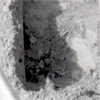 |
 |
Giant Moon illusion
Wednesday night the Moon will hover above the horizon, appearing roughly twice as large as it does when it reaches the highest point in our sky. We all know that the Moon doesn’t really change size, so let us remind ourselves how the Moon is tricking us, or rather, how our minds are deceiving us.
 FULL STORY FULL STORY
 |
 |
 |
 |
First results from Phoenix bakery
After a difficult time delivering soil samples to one of the ovens onboard Phoenix, the results are now in from the first round of baking: no water, yet.
 FULL STORY FULL STORY
 |
 |
 |
 |
Sun sets on Ulysses mission
After more than 17 years dedicated to exploring the effects of solar activity on the space that surrounds us, the sun is setting on the Ulysses mission and will finally fade into darkness on July 1, but its legacy will live on.
 FULL STORY FULL STORY
 |
 |
 |
 |
Trio of super-Earths discovered
A harvest of low mass planets has been discovered with the High Accuracy Radial Velocity Planet Searcher (HARPS) at the ESO La Silla Observatory, and 45 other candidate planets with masses below 30 Earth masses have also been identified.
 FULL STORY FULL STORY
 |
 |
 |
 |
A new type of comet dust mineral
NASA researchers have found a new mineral in a material that likely originated from comet 26P/Grigg-Skjellerup, which orbits the Sun once every five years.
 FULL STORY FULL STORY
 |
 |
 |
 |
Pluto assigned 'plutoid' tag in new IAU classification
Almost two years after the International Astronomical Union (IAU) caused a worldwide furore by stripping Pluto of its former status as a 'proper' planet to a dwarf planet, the term 'plutoid' has been introduced to describe "Pluto-like transneptunian dwarf planets".
 FULL STORY FULL STORY
 |
 |
 |
 |
An oven full of sand
After several attempts, Phoenix has finally succeeded in filling one of its ovens with Martian soil, ready to sniff out and assess its ingredients, such as water.
 FULL STORY FULL STORY
 |
 |
 |
 |
Hubble brings galaxies out of coma
NASA’s Hubble Space Telescope has captured the magnificent starry population of the Coma Cluster galaxies, one of the densest known galaxy stockpiles in the Universe.
 FULL STORY FULL STORY
 |
 |
 |
 |
Amateurs help radio astronomers glimpse astrophysical jet
The first astrophysical radio jet has been detected from an outbursting white dwarf nova, an observation that wouldn’t have been possible without the help of amateur astronomers, and one which suggests that all compact accreting binary systems are capable of creating radio jets.
 FULL STORY FULL STORY
 |
 |
 |
 |
Successful first test of high speed Moon penetrator
High speed penetrators that could one day be used to breach the surface of planets, moons and asteroids have successfully passed their first test in the UK, accelerating to over 1000 kilometres per hour and 20,000 gee at the point of impact.
 FULL STORY (INCLUDES VIDEO) FULL STORY (INCLUDES VIDEO)
 |
 |
 |
 |
Journey to the centre of the Sun
NASA is planning a mission to the Sun that will go closer to our life-giving star than any spacecraft has ever gone before to solve two of the greatest mysteries of solar physics.
 FULL STORY FULL STORY
 |
 |
 |
 |
Clumpy Martian soil challenges Phoenix instruments
Phoenix engineers are testing a revised method for delivering soil samples to laboratory instruments onboard the lander now that researchers appreciate just how clumpy the soil is at the landing site.
 FULL STORY FULL STORY
 |
 |
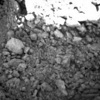 |
 |
Baby quasar detected near edge of visible Universe
An international group of radio astronomers using the European Very Long Baseline Interferometry Network has found an unexpected morphology in the most distant radio quasar ever.
 FULL STORY FULL STORY
 |
 |
 |
 |
Cassini sees collisions of moonlets in Saturn’s ring
The rapid changes in Saturn’s F ring can be attributed to small moonlets embedded within the ring causing perturbations and collisions, say a team of UK-led scientists who published their findings in Nature last week.
 FULL STORY FULL STORY
 |
 |
 |
 |
Extremely little telescope to hunt for Earthlike planets
Astronomers from Vanderbilt University are preparing the Kilodegree Extremely Little Telescope (KELT) to go online, which will become only the second dedicated planet-finder in the southern hemisphere.
 FULL STORY FULL STORY
 |
 |
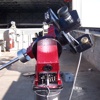 |
 |
Closest view ever of Mars sand
Dust grains as small as one-tenth the thickness of a human hair have been imaged by NASA’s Phoenix Lander, the greatest resolution ever returned from another planet.
 FULL STORY FULL STORY
 |
 |
 |
 |
Contact with ET may be sooner than we think
It has been the question on the lips of astronomers ever since we began turning our radio telescopes to the skies and listening for extraterrestrial signals: where are they? Now a new study has suggested that we’ve been looking in the wrong places all along.
 FULL STORY FULL STORY
 |
 |
 |
 |
EPOXI checks out super-Earth planet
The innovative Deep Impact spacecraft, which sent a coffee-table sized penetrator slamming into comet Tempel-1 almost three years ago, has now begun its new job as “super-Earth” planet hunter “EPOXI”.
 FULL STORY FULL STORY
 |
 |
 |
 |
Recipe for giant lunar telescopes
Scientists working at NASA's Goddard Space Flight Centre have concocted an innovative recipe for making giant telescope mirrors on the Moon: simply take a pinch of carbon, a handful of epoxy, and a generous helping of lunar dust.
 FULL STORY FULL STORY
 |
 |
 |
 |
When black holes snuff out star formation
As galaxies reach a critically monstrous size of 10 billion times the mass of the Sun, their stormy centres, powered by supermassive black holes, or Active Galactic Nuclei, take over from supernovae as the main mechanism by which the gas that fuels star formation is dispersed, say scientists presenting their work at the 212th American Astronomical Society Meeting this week.
 FULL STORY FULL STORY
 |
 |
 |
 |
Giant Milky Way mosaic unveiled
More than 800,000 snapshots from NASA’s Spitzer Space Telescope have been stitched together to create a cosmic tapestry of stars in the Milky Way, spanning an area of sky 120 degrees wide by two degrees tall.
 FULL STORY FULL STORY
 |
 |
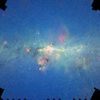 |
 |
Second supernovae point to quark stars
Three of the most luminous supernova explosions ever observed could be the signatures of weird pseudo-stellar objects known as quark stars, according to a pair of scientists from the University of Calgary, Canada.
 FULL STORY FULL STORY
 |
 |
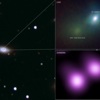 |
 |
Milky Way loses two arms but gains a spare
New detailed images from NASA’s Spitzer Space Telescope are shedding light on the true structure of the Milky Way, revealing that it has just two major arms of stars instead of the four it was previously thought to possess. Meanwhile, astronomers using ground-based telescopes discover the missing 3-kiloparsec arm.
 FULL STORY FULL STORY
 |
 |
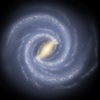 |
 |
Suspiciously slow stars surprise astronomers
Ultra-precise radio measurements from the Very Long Baseline Array (VLBA) have given astronomers a detailed look at the motions of the Milky Way’s young stars and reveal that they are orbiting much slower than expected in strangely elliptical paths.
 FULL STORY FULL STORY
 |
 |
 |
 |
White dwarf lost in planetary nebula
A team of astronomers is on the trail of a mysterious case of a missing white dwarf star, presumed lost in planetary nebula SuWt 2, 6,500 light years from Earth towards the constellation Centaurus.
 FULL STORY FULL STORY
 |
 |
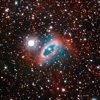 |
 |
Phoenix scoops up Martian soil
One week after landing on the Red Planet, Phoenix lifted its first scoop of Martian soil as a test of the lander’s 2.35 metre long Robotic Arm.
 FULL STORY FULL STORY
 |
 |
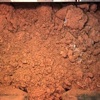 |
 |
Smallest extrasolar planet found
An international team of astronomers has discovered an extrasolar planet just three times the mass of Earth orbiting a star so small that it may not be massive enough to maintain nuclear reactions.
 FULL STORY FULL STORY
 |
 |
 |
 |
GLAST readies its gamma ray vision
Excitement is mounting as NASA's state-of-the-art Gamma ray Large Area Space Telescope (GLAST) prepares for launch later this week to explore the most extreme environments of the Universe.
 FULL STORY FULL STORY
 |
 |
 |
 |
Phoenix sees possible ice
Scientists have discovered what may be ice underneath the Phoenix lander, exposed when soil was blown away as it landed in the northern polar plains of Mars last week.
 FULL STORY FULL STORY
 |
 |
 |
 |
Cassini primed for extended tour of Saturn
On May 28, the Cassini spacecraft successfully completed a flyby of Saturn’s moon Titan, the last flyby of the original four-year tour, but Cassini’s exploration of Saturn will now continue with a two-year extended mission.
 FULL STORY FULL STORY
 |
 |
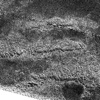 |
 |

Back to latest news |
 |

